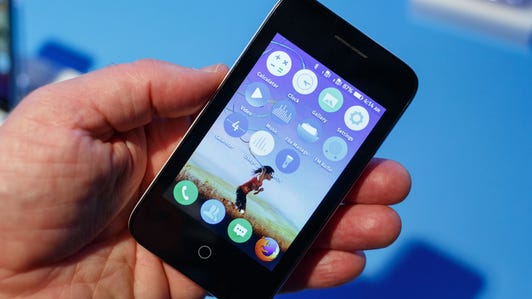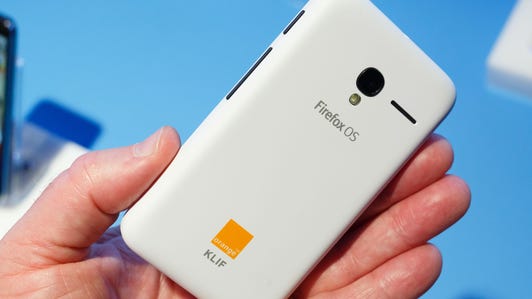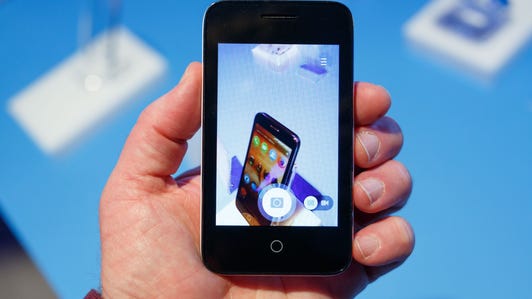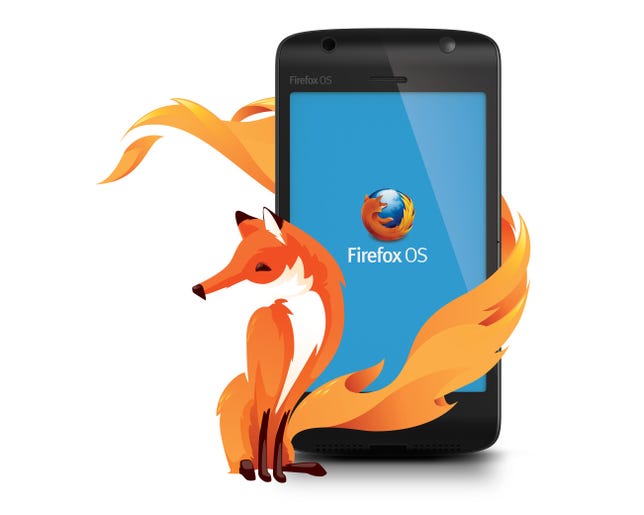
Stephen Shankland/CNET
BARCELONA — By bundling a Firefox OS phone called the Klif with six months of data and voice service, French carrier Orange hopes to bring smartphones to millions of Africans who today can afford only plain old feature phones.
The Klif, announced at the Mobile World Congress show here, move is a ringing endorsement of Mozilla’s Firefox OS plan, which aims to break down some of the barriers in the mobile market by spreading its browser-based operating system. Mozilla concluded that the market most vulnerable to attack is a super low-budget category in developing nations, where Google’s Android operating system isn’t an option because it requires more powerful, expensive hardware.
“We will address this part of the population who still don’t have access to the Internet,” said Yves Maitre, Orange’s executive vice president of connected objects and partnerships. “In this part of the world, the smartphone penetration is 11 percent. In sub-Saharan countries, it’s around 5 percent.”
Smartphones have swept the world, providing new ways for people to communicate, share photos, purchase products, play games, watch video and learn what’s going on. But the novelty has worn off in wealthier countries, where smartphone market is relatively saturated. Developing countries, in contrast, are ripe for growth.
Orange Klif, Firefox OS’s $40 phone for Africa (pictures)






Orange will sell the phone with voice and text-messaging services, but it’s the 500MB per month of 3G data service that the company thinks will stand out. And even though it’s inexpensive, it’ll still be profitable for the company, even if customers don’t stick with Orange beyond the initial six-month period.
The phone package will go on sale in the second quarter in 13 countries — Egypt, Senegal, Tunisia, Cameroon, Botswana, Madagascar, Mali, Ivory Coast, Jordan, Niger, Kenya, Mauritius and Vanuatu. Orange today has 180 million customers. Orange, which has 97.5 million customers in Africa and the Middle East, also does business in Equatorial Guinea, Guinea Bissau, Guinea Conakry, Morocco, the Republic of Central Africa and the Democratic Republic of Congo, so it’s a major ally for Mozilla.
Selling millions
Maitre wouldn’t detail how Firefox OS phone sales projections, but said, “We expect millions.”
The Middle East and Africa should see 33 percent growth in 2015, according to analyst firm GfK. The area has “significant room for growth as consumers migrate from feature phones and existing smartphones to trade up to a bigger screen.”
Android has taken off, though, even if not everyone can afford it. In the fourth quarter of 2011, only 4 percent of phones shipped with Google’s OS in the Middle East and Africa, but by 2014, it rose to 42 percent, GfK said. Meanwhile, feature phone shipments dropped from 80 percent to 49 percent during that period.


Mozilla
The Klif won’t compete against flagship phones arriving at Mobile World Congress like the Samsung Galaxy S6 or the HTC One M9 . But it is a good phone, Maitre said.
“When the working group started on this proposal, we all decided either we would reach something really breakthrough with good quality or we don’t do it,” Maitre said. “We don’t want is to give something low-level.”
The phone itself has a 3.5-inch 480×320 screen, a 2-megapixel camera, 512MB of storage, 1300mAh battery and 256MB of memory. Powering it is a 1GHz MediaTek processor that’s exclusive to Orange, said marketing director Guillaume de Riberolles.
So how much cheaper is it than an Android smartphone?
The company’s cheapest Android phone, the Pixi, costs about 40 percent more than the Klif, and that’s with no data plan, Maitre said. “The hardware specs requested by Android Lollipop are much higher than the ones we have with with Mozilla’s Firefox OS 2.0 and 2.2 at the end of the year,” he said.


Now playing:
Watch this:
Klif Firefox phone wants to bring smartphone tech to…
1:37
Why Firefox OS?
It wasn’t just a matter of price, though. Firefox OS also works in local languages that Android doesn’t support, he added, and Mozilla supports carrier billing in countries where Google still only accepts payments by credit card.
“We hope a partner like Google will realize they need to open their billing system,” Maitre said.
Firefox OS also doesn’t require any signup — no Gmail account, for example — and even works with customers who are illiterate, Maitre added.
“They should be able to take the phone out of the box and start using it without creating any email account,” Maitre said. “With Mozilla, you take phone, put in the battery, put in the SIM card, and you run. That’s it. Most of these people are not used to complicated registration. It is a little bit scary to go away from feature phone.”
Firefox OS got its big start in Latin America but also is an option in eastern Europe, India, and some Asian nations. Until now, though, Mozilla didn’t have any carrier partners bringing the technology to Africa.
“This is an important step for us,” said Mozilla Chief Technology Officer Andreas Gal about the push to Africa and the Middle East. It also will help the company push to Firefox OS 2.0, the first version to support right-to-left languages like Arabic.
What Firefox OS needs
Orange is a Firefox OS fan, but it’s not dropping its Android line.
“We’ve been absolutely successful with the Pixi. We will not stop selling it. It’s not addressing the same market segment,” Maitre said.
And Firefox isn’t perfect, either, added Jean-Marc Polga, Orange’s device program manager. It needs even more local-language support, for one thing. “We also want to see them develop the ecosystem,” meaning Mozilla needs to encourage more programmers to write apps that are relevant. “That’s one area they’re going to have really start to work on.”



